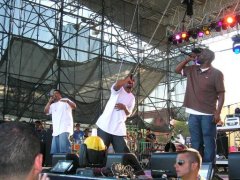De La Soul
At the time of its 1989 release, De La Soul's debut album, 3 Feet High and Rising, was hailed as the future of hip-hop. With its colorful, neo-psychedelic collage of samples and styles, plus the Long Island trio's low-key, clever rhymes and goofy humor, the album sounded like nothing else in hip-hop. Where most of their contemporaries drew directly from old-school rap, funk, or Public Enemy's dense sonic barrage, De La Soul were gentler and more eclectic, taking in not only funk and soul, but also pop, jazz, reggae, and psychedelia. Though their style initially earned both critical raves and strong sales, De La Soul found it hard to sustain their commercial momentum in the '90s as their alternative rap was sidetracked by the popularity of considerably harder-edged gangsta rap.
De La Soul formed while the trio -- Posdnuos (born Kelvin Mercer, August 17, 1969), Trugoy the Dove (born David Jude Jolicoeur, September 21, 1968), and Pasemaster Mase (born Vincent Mason, March 27, 1970) -- were attending high school in the late '80s. The stage names of all of the members derived from in-jokes: Posdnuos was an inversion of Mercer's DJ name, Sound-Sop; Trugoy was an inversion of Jolicoeur's favorite food, yogurt. De La Soul's demo tape, "Plug Tunin'," came to the attention of Prince Paul, the leader and producer of the New York rap outfit Stetsasonic. Prince Paul played the tape to several colleagues and helped the trio land a contract with Tommy Boy Records.
Prince Paul produced De La Soul's debut album, 3 Feet High and Rising, which was released in the spring of 1989. Several critics and observers labeled the group as a neo-hippie band because the record praised peace and love as well as proclaiming the dawning of "the D.A.I.S.Y. age" (Da Inner Sound, Y'all). Though the trio was uncomfortable with the hippie label, there was no denying that the humor and eclecticism presented an alternative to the hardcore rap that dominated hip-hop. De La Soul quickly were perceived as the leaders of a contingent of New York-based alternative rappers which also included A Tribe Called Quest, Queen Latifah, the Jungle Brothers, and Monie Love; all of these artists dubbed themselves the Native Tongues posse.
For a while, it looked as if De La Soul and the Native Tongues posse would eclipse hardcore hip-hop in terms of popularity. "Me, Myself and I" became a Top 40 pop hit in the U.S. (number one R&B), while the album reached number 24 (number one R&B) and went gold. At the end of the year, 3 Feet High and Rising topped many best-of-the-year lists, including The Village Voice's. With all of the acclaim came some unwanted attention, most notably in the form of a lawsuit by the Turtles. De La Soul had sampled the Turtles' "You Showed Me" and layered it with a French lesson on a track on 3 Feet High called "Transmitting Live From Mars," without getting the permission of the '60s pop group. The Turtles won the case, and the decision not only had substantial impact on De La Soul, but on rap in general. Following the suit, all samples had to be legally cleared before an album could be released. Not only did this have the end result of rap reverting back to instrumentation, thereby altering how the artists worked, it also meant that several albums in the pipeline had to be delayed in order for samples to clear. One of those was De La Soul's second album, De La Soul Is Dead.
When De La Soul Is Dead was finally released in the spring of 1991, it received decidedly mixed reviews, and its darker, more introspective tone didn't attract as big an audience as its lighter predecessor. The album peaked at number 26 pop on the U.S. charts, number 24 R&B, and spawned only one minor hit, the number 22 R&B single "Ring Ring Ring (Ha Ha Hey)." De La Soul worked hard on their third album, finally releasing the record in late 1 993. The result, entitled Buhloone Mindstate, was harder and funkier than either of its predecessors, yet it didn't succumb to gangsta rap. Though it received strong reviews, the album quickly fell off the charts after peaking at number 40, and only "Breakadawn" broke the R&B Top 40. The same fate greeted the trio's fourth album, Stakes Is High. Released in the summer of 1996, the record was well reviewed, yet it didn't find a large audience and quickly disappeared from the charts.
Four years later, De La Soul initiated what promised to be a three-album series with the release of Art Official Intelligence: Mosaic Thump; though reviews were mixed, it was greeted warmly by record buyers, debuting in the Top Ten. The second title in the series, AOI: Bionix, even featured a video hit with "Baby Phat," but Tommy Boy and the trio decided to end their relationship soon after. De La Soul subsequently signed their AOI label to Sanctuary Urban (run by Beyoncé's father, Mathew Knowles) and released The Grind Date in October 2004. Two years later the group issued Impossible Mission: TV Series, Pt. 1, a collection of new and some previously unreleased material.
(text by Stephen Thomas Erlewine, All Music Guide)
